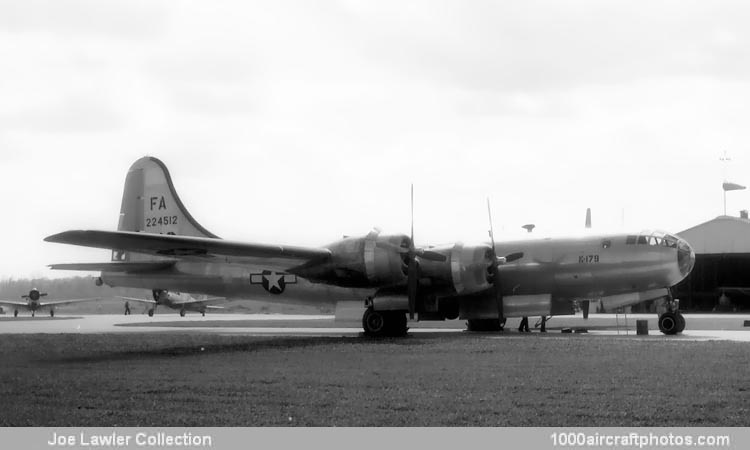02/28/2010. Remarks by Johan Visschedijk: "Initial studies that were to result in the famous Superfortress began in 1938 with a Boeing proposal to the USAAC for an improved B-17 with a pressurized cabin to increase crew efficiency and comfort during long high-altitude missions. There were no military requirements for such a design at the time, but Boeing, with USAAC encouragement, kept updating the design in the light of anticipated requirements.
Finally, in February 1940, an official invitation was received to bid on a high-altitude long-range bomber. After several major revisions to meet constantly changing requirements, the design became Model 345 and three aircraft, with a fourth for static test, were ordered as XB-29. When the first XB-29 prototype (41-002) first flew on September 21, 1942, it was as far ahead of its contemporaries.
The ten-gun defensive armament was concentrated in four remote-controlled power turrets on the fuselage and in a single directly-controlled turret in the tail, which carried three guns: two 0.50 in (12.7 mm) and a 0.787 in (20 mm) cannon. The fuselage was divided into three pressurized compartments; one in the nose for the pilots, bombardier, and flight engineer and one amidships for the gunners and observers. The two were connected by a tunnel over the tandem bomb bays. A separate pressurized area was provided for the tail gunner.
Each of the four 2,200 hp Wright R-3350-23 radial engines was fitted with two turbo-superchargers. Dual wheels were installed on each leg of the tricycle landing gear to support the 105,000 lb (47,627 kg) gross weight. Wing loading was an unprecedented 58 lb/sq.ft (283.18 kg/sq.m), which was to be increased by an additional 10 lb (48.82 kg) in later models. Satisfactory take off and landing characteristics at this weight were achieved with the high-speed Boeing 117-airfoil through use of Fowler flaps, which not only increased lift when deflected but added to wing area by extending aft out of the wing as well as downward.
Even before the prototype was completed the USAAF ordered large scale production. The Wichita division plant was expanded for the purpose and Bell and Martin were ordered to build B-29s in new plants to be constructed at Marietta, Georgia and Omaha, Nebraska. The Boeing Renton Plant, originally built for the Navy PBB-1 flying boat program, was transferred to USAAF jurisdiction and devoted to B-29A production.
B-29 production became the largest single aircraft program of WW II. It entailed not only a multi-plant production complex and thousands of subcontractors, but also modification centers where last-minute changes and refinements expeditiously could be made without slowing the expanding assembly lines.
B-29s first bombed Japan in June, 1944, less than two years after the initial flight of the XB-29. As enemy fighter opposition diminished toward the end of WW II, it was possible to improve the speed of the B-29s by deleting the gun turrets and sighting blisters. These stripped versions were designated B-29B; B-29A having been assigned to Renton-built aircraft which featured a different type of center wing construction.
Altogether, 3,970 B-29s were built when production terminated in 1946; 2766 by Boeing, 668 by Bell, and 536 by Martin. The end of the war resulted in the cancellation of an additional 5,092 B-29s on order, after Wichita's production rate had reached 85 per month.
Postwar years saw further development of the B-29 for a great variety of purposes. Like the B-17, it was adapted to carry air-borne lifeboats and for anti-submarine and weather duty. It served as a flying power plant laboratory with a retractable jet engine mounted in the bomb bay. Its size made it an efficient 'Mother Ship' for supersonic research aircraft that had to be carried aloft for launching. Postwar B-29s served the RAF as Boeing Washingtons.
An entirely new career was opened for the B-29 with the advent of aerial refueling as a means of extending the range of bombers and fighters. Under the designation KB-29M, 72 B-29s were converted at Wichita to flying tankers with a single large fuel tank filling each bomb bay, transfer pumps, and a hose that could be unreeled and secured to the receiver airplane. Seventy-four B-29s were modified to receive fuel by this method, with one bomb bay used for increased fuel capacity.
The B-50A 'Lucky Lady 11' made the first non-stop flight around the world in 1949 after being refueled by six KB-29Ms at three points en route. The drawbacks of the hose refueling system were overcome by Boeing development of the 'Flying Boom', which permitted a direct mechanical connection between the planes and much higher fuel transfer rates. One hundred and sixteen B-29s were modified at Renton as KB-29P 'Flying Boom' tankers. The last B-29s in squadron use were retired from service in September, 1960.
Pictured is an early Superfortress model, a B-29-30-BW produced at Wichita."
